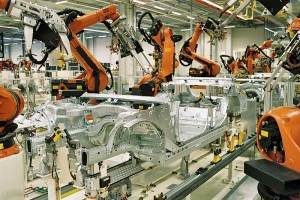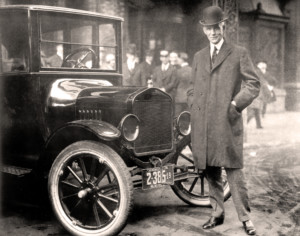 The flow shop is usually preferred for most lean production systems. In a flow shop, the processes are arranged in the sequence of the production steps. If you can manage to establish a flow shop, your production will be much more efficient than in a job shop or a project shop. In this post I want to talk in more detail about the flow shop. Be warned, this will be a bit of an ode to the flow shop 🙂 .
The flow shop is usually preferred for most lean production systems. In a flow shop, the processes are arranged in the sequence of the production steps. If you can manage to establish a flow shop, your production will be much more efficient than in a job shop or a project shop. In this post I want to talk in more detail about the flow shop. Be warned, this will be a bit of an ode to the flow shop 🙂 .
The Flow Shop

In a flow shop, the processes are arranged in the sequence that the parts are processed. The best known example is the assembly line, but there are many others.
This type of production system is usually the ultimate goal of any lean system. In fact, most of the writing in manufacturing and many of the lean methods concern the flow shop. The other methods, job shop and project shop, often feel even neglected to me. But then, it is just so much easier to perfect a flow shop than the other two.
Repeatability!
The big advantage of the flow shop is its repeatability! All work steps are repeated (ideally in identical form) over and over again within a short time period. One example would be an automotive assembly line, where the work content of every station is around one to three minutes before the process is completed and the cycle starts anew. Machine tool makers and aircraft assembly lines may have a cycle of a few hours (see Trumpf for an example), which is longer than a car maker but still much faster than the job shop or project stop alternatives. This repeatability gives a lot of enormous benefits.

Repetitive process cycles make optimization easier for humans! Human workers can learn one to three minutes of repeating work in an assembly line much easier than learn the always-different work in a job shop. For example, a lathe worker that is suited for job shops would need a long and costly education and years of practice to achieve mastery, and would command a higher salary. Teaching a worker a three-minute work content is done in a few days to achieve mastery (or even hours, but you should not cut it too short – see Operator Training at Toyota and Scania for an example). Labor cost is usually lower too, although the workers would prefer the higher salary, of course. To prevent boredom, the worker can work at different tasks at different times.

Repetitive process cycles make optimization easier for machines! Optimization is also easier for machines. If a work cell or robot always handles the same parts, it is much easier to mechanize and automate. Since the work content is much smaller, it is a lot easier to program a multipurpose machine. In fact, since the work content is (nearly) identical each time, it is also much easier to adapt the hardware. Rather than a (slower) multipurpose machine, you have a faster dedicated machine exactly for this process.

Much easier logistics! The repeatability applies not only to the processes but also to the logistics. Since the steps are identical and always at the same spot, knowing what to bring where is so much easier. Part A always goes to process X, and Part B to process Y. Additionally, it is not only the same location but also the same frequency. Rather than a part per hour, day, or even less, the parts are needed by the minute or second. The material flow is not only with a clear source and destination, but also much higher frequency than job shops. This makes it much easier for human logistic workers to improve, be more efficient, and reduce errors. As above, this applies also to automation and mechanization. Since the material flow is now so constant, you can automate the material flow (for example, with a conveyor belt). In contrast, a conveyor belt usually makes no sense at all in a job shop.
Clarity!
Another big benefit of flow shops is clarity. This is a direct result of the repeatability from above, but since it is host to so many other advantages, I want to give it its own heading. As repeatability helps in making a fast and efficient system in the first place, clarity helps in improving it.
Easier to create standards! Since the work repeats in short cycles, it is so much easier to create good standards. There are (ideally) no exceptions and decisions in the standard, and the standard covers only a short period of time that repeats frequently.

Easier to see problems and potentials! This is a big one! Due to the repeating identical work, it is much easier to see problems. These may be deviation from the standard, recurring problems, or just potentials for improvement. A chalk circle exercise is much easier in a flow shop than in a job shop. Related to this, visual management is also much easier in a flow shop. Since the sequence is always the same, it is much easier to, for example, see if there is a lot or little inventory at a certain spot.
Easier to improve! Since it is so much easier to see problems, it is also so much easier to improve them. The implementation is also helped by the repeatability.
Easier to predict! Due to its repeatability and clarity, the behavior of the flow shop is also much easier to predict. Contrast this with the planning problems at the job shop. No matter which parameter, they are all much easier to estimate beforehand with much less fluctuations compared to a job shop or project shop. Take for example Lead Time (i.e., when the product will be ready for the customer), Machine Utilization and Capacity (i.e., do I have enough machine capacity to satisfy the customer?), Worker Assignment (i.e., which machine should be manned when), WIP Inventory (i.e., the stuff on the shop floor), and many more. Planning is, while still challenging, no longer a complete mess like in the job shop.
Gargantuan Benefits!
 When switching from a project shop or job shop to a flow shop, the benefits can be gargantuan (you know, I’ve always liked that word … gargantuan … so rarely have an opportunity to use it in a sentence). Any example I have seen where a job shop was converted into a flow shop resulted in gargantuan benefits.
When switching from a project shop or job shop to a flow shop, the benefits can be gargantuan (you know, I’ve always liked that word … gargantuan … so rarely have an opportunity to use it in a sentence). Any example I have seen where a job shop was converted into a flow shop resulted in gargantuan benefits.
While most examples I have are subject to a confidentiality agreement, I can talk about a few historic examples. An early example is James Bonsack and his cigarette-rolling machine in 1881. He transformed cigarettes from a luxury item to a commodity. Reducing production cost to 1/6th (even after including the price of the machine), he was able to supply all of America from two production lines. Another example: The first match sticks production line in 1880 improved productivity seven-fold. I could expand this list with canning, soap, sugar, toilet paper, and many more. Many of the famous brands you know started around that time: Diamond Matches, Quaker Oats, Campbell Soup, Procter & Gamble Ivory Soap, Heinz Tomato Ketchup; all had gargantuan growth due to the possibilities of a flow shop.

Most famous, of course, is Henry Ford. Around 1913, Henry Ford switched from a project shop car assembly to the famous assembly line. For the magneto line (the generator), the labor time was reduced from 20 minutes to 5 minutes per part. For the axle line it was reduced from 150 to 26.5 minutes. Transmission assembly from 18 to 9 minutes. Engine assembly from 594 to 226 minutes. Final assembly from 12.5 hours per car to 93 minutes per car. Depending on the component, there was an improvement between 50% and 1000% for the labor cost. With improvements, over time, the Model T price was reduced from $850 in 1908 (around $20,000 nowadays) to $260 at its lowest in 1925 (or around $3,600 nowadays). Henry Ford became one of the richest men in America (net worth at his death over $180 billion).
This is not to say that a flow shop alone will give these benefits. But it makes it much easier! It allows easier mechanization, higher quantity production, and more importantly, it allows faster continuous improvement. The companies above utilized these possibilities and reaped gargantuan benefits.
Disadvantages
However, as usual, there are some disadvantages. Most importantly, a flow shop usually has a much lower flexibility. This is first for product variants. Since the processes are organized around the work sequence of a product group, it is difficult or impossible to adapt it to a different product group. Similarly, it is more difficult to adjust capacity. While in many cases multi-machine handling allows production rates below maximum capacity, it is difficult to increase capacity beyond the maximum. In a flow shop, you usually would need a complete new line. In a job shop, you simply add the machines you need. In a flow shop, if the line for product A needs more capacity, it does not help if the line for product B has excess available. In a job shop, other machines could be used.
Additionally, setting up a flow shop is more work than a job shop, but this is usually offset by the gargantuan benefits. The price is also often higher, but this is mostly due to the machines being more automated and hence faster. In a job shop, you could just rearrange the machines to a flow shop without additional cost. Yet to achieve the full benefit of a flow line, higher automation is often a good step.
Summary

Overall, a flow shop and its many variants (assembly line, transfer line, etc.) usually have gargantuan benefits. Hence, even products that are difficult to imagine as flow shops are converted to flow production. Examples include aircraft (Boeing, Airbus, etc.), large ships, huge ship engines, and many more.
As I have said before, the benefits can be gargantuan (which makes it now nine times I have used that word in this post. I’ll stop now, I promise). Now, go out, see if you can change your production (or even parts of it) into a flow line, and organize your industry!
P.S.: If you want to know more about the history of the assembly line, check out my book “Faster, Better, Cheaper” in the History of Manufacturing: From the Stone Age to Lean Manufacturing and Beyond:

Hi – Mr Roser,
Your posts are always insightful… well written, practical and insightful. I refer to them all the time in my practice.
I think you glossed over the disadvantages… specifically, flexibility. Perhaps in the future you can write a post/article on the concept of “product of one” – vis-a-vis, the current desire from businesses in my practice.
My quick thoughts are around balancing production leveling and standardization. I just feel an integration article between those two…or other insights… to address “production of one” would be amazing.
Thanks,
Peter Meissner
Hi Peter, interesting thought. This sounds a bit like “mass customization”, i.e. every product is unique but costs only as much as a mass produced product. I have to think more about it, but it would be an interesting article. I put it on my “toDo” list, although I am not sure when I get around to write about it. In any case, thanks for the compliments and for the input 🙂
Chris
I work as a lean specialist in healthcare and find this type of post really interesting. So much to learn from non-healthcare settings and the industrial engineering roots of lean. The images help too!
Hi Ted, many thanks. I am always surprised how well many of the lean approaches work for other industries like banking, retail, government, and – of course – healthcare. The lean blog by Mark Graban is probably also a good resource particularly on lean healthcare.